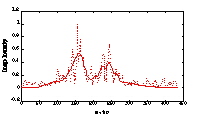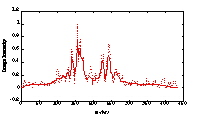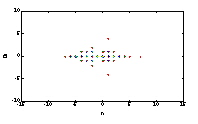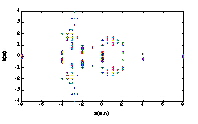

Multipath Channel Mitigation/Exploitation - LSI’s technical capabilities
include rigorous physics based characterization of propagation channels.
Mitigation and exploitation experience include HF OTH radar, as well as low
altitude/surface surveillance. The figure below illustrates the utilization
of modest frequency diversity and coherent range gate processing to not only
maintain, but enhance detection of a low flying (30 ft) target using
 a wideband linear FM X-band airborne radar operating from a 5,000 ft
altitude. The upper left figure represents the temporal window of the
channel, and the upper right figure illustrates the multipath fading experienced
by the linear FM waveform as a function of range. The figure on the
lower left illustrates the performance improvement that results in the interference
region from frequency diversity. The figure on the lower right combines
frequency diversity with coherent range gate processing in the resolved regime,
and formats the combined result to emulate the host radar’s display.
The overall range dependent performance is summarized in the figure below
with the red line indicating the initial multipath fade conditions and the
dark blue line indicating the detection performance enhancement achieved through
frequency diversity and range gate processing. Also indicated are the
resolved and unresolved multipath regimes in addition to the intermediate
region near the horizon where geometric optics techniques are no longer adequate
to describe the propagation conditions.
a wideband linear FM X-band airborne radar operating from a 5,000 ft
altitude. The upper left figure represents the temporal window of the
channel, and the upper right figure illustrates the multipath fading experienced
by the linear FM waveform as a function of range. The figure on the
lower left illustrates the performance improvement that results in the interference
region from frequency diversity. The figure on the lower right combines
frequency diversity with coherent range gate processing in the resolved regime,
and formats the combined result to emulate the host radar’s display.
The overall range dependent performance is summarized in the figure below
with the red line indicating the initial multipath fade conditions and the
dark blue line indicating the detection performance enhancement achieved through
frequency diversity and range gate processing. Also indicated are the
resolved and unresolved multipath regimes in addition to the intermediate
region near the horizon where geometric optics techniques are no longer adequate
to describe the propagation conditions.
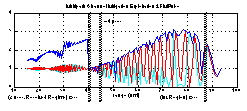
Distributed Scatterer (Target) Characteristics - LSI maintains
considerable expertise in distributed target and clutter scattering phenomenology
for the purposes of enhanced detection, discrimination and identification.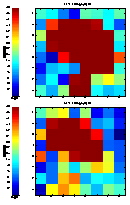
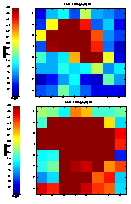 Military applications include automatic target recognition (ATR)
combined with foliage penetration (FOPEN) and ground penetration (GPEN) surveillance
sensors. Techniques that mitigate and/or
Military applications include automatic target recognition (ATR)
combined with foliage penetration (FOPEN) and ground penetration (GPEN) surveillance
sensors. Techniques that mitigate and/or
exploit target and clutter scattering phenomenology also typically involve
advanced signal processing concepts. For example, the figure on the
left illustrates the co-pol and cross-pol high resolution SAR signature of
a distributed scatterer embedded in clutter. The differences in the
individual polarimetric image components illuminate the polarimetric diversity
of the individual scattering centers that comprise the distributed scatterer.
LSI developed an extension to the Rayleigh quotient based polarimetric matched
filter (PMF) (known as the distributed PMF (DPMF)) that exploits the individual
scattering centers that comprise the distributed scatterer. The DPMF
response can be optimized for either detection, discrimination or identification.
The figure below illustrates a sample DPMF image result for the distributed
scatterer shown on the left. Also shown is the corresponding span image.
The DPMF result shown was formulated to enhance the signal-to-noise ratio
(SNR).

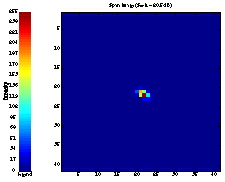
A second example shown below illustrates the characterization of a distributed scatterer using coherent frame decompositions and reconstructions (time-frequency analysis techniques). The top two figures represent full reconstructions (dotted line) and 75% energy reconstructions (solid line). The bottom two figures illustrate the corresponding phase space signatures associated with the 75% reconstruction results. Results for the Weyl-Heisenberg frame are shown on the left, and results for the affine (or wavelet) frame are shown on the right. The results in both cases illustrate information compression and feature extraction useful for ATR. The
